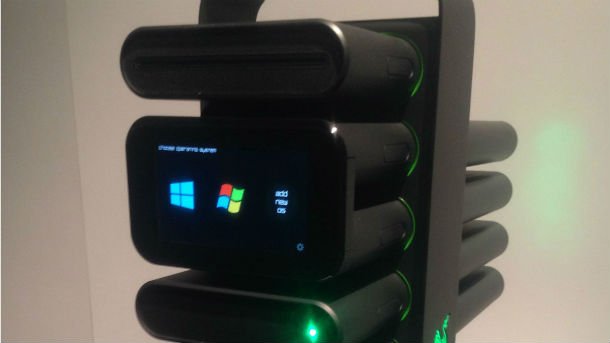Razer CEO hopes Project Christine will make upgrades easy for casual gamers

Written by Jonathan Deesing
Tuesday at the International CES, Razer unveiled Project Christine —its newest product aimed at creating a fully modular high-end gaming PC. At first glance, it hardly looks like a PC at all, but each of its strange modular spokes is a computer component.A thermal cooling tower forms a backbone, which has a number of modules that snap in and out. The modules—roughly the size of a paperback book—represent various components of a computer such as its GPU or CPU.
“Christine is something we're really passionate about,” Razer CEO Min-Liang Tan tells PC Gamer. “It has a huge amount of potential right now.” That potential, Tan explains, rests in modular computing. “With a fully modular design, we can reinvent the entire way PCs are being viewed.”
Project Christine is modular in not only its hardware, but also its software. It will ship without any bloatware, according to Razer, and a new OS can be added easily at any point. Yes, this includes SteamOS. “Hopefully a lot of people are going to want to install SteamOS on this,” Tan tells me.
Though he is excited about what Valve is doing with its Steam Machines , Tan wants to avoid creating a single-use product, an appliance. “Real estate is fine,” he explained. Project Christine is not a small device, but that doesn't mean it's not sexy. The thermal cooling tower at its center uses mineral oils instead of water or fans. Each module's two ports are double-sealed which makes for only slight dampness when switching them out. “When we built it we wanted it to be fully modular and totally quiet,” Tan said of Razer's goals, “This allows us to overclock it like crazy.”

Razer believes its modular setup will allow even casual PC users to easily upgrade to higher-end components. Tan envisions a tiered sales structure, in which players choose which level of computer they need and pay a subscription fee. For example, when a tier one gamer receives the latest and greatest CPU module, he could simply ship back his old one, which Razer would refurbish and send to a tier two gamer. This type of system upgrading is not too far removed from gamers who replace computer components on a regular basis, with the exception that the components would have to come from Razer.
The company calls this process open, but the reliance on Razer for component choices seems like a more limiting move. Sure, it will be easy to slot in a new GPU, but only if it's a GPU that Razer approves. That lack of choice will ruffle feathers for system builders or those used to choosing their own upgrade paths.
The biggest gaming news, reviews and hardware deals
Keep up to date with the most important stories and the best deals, as picked by the PC Gamer team.
It's still a prototype, so Razer has no price or date for release, but Tan's insistence on reaching casual gamers suggests a potentially lower-than-average price for a gaming rig. Exactly how that will happen remains unclear. For now, Project Christine is an interesting proof of concept for how easy computer upgrades could be.


